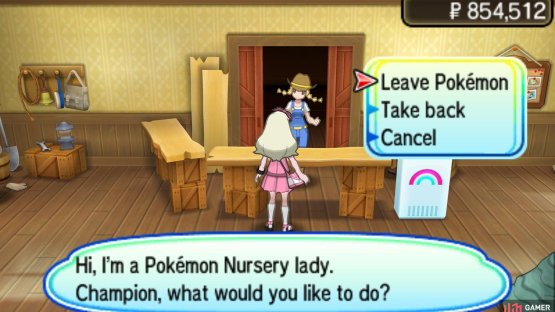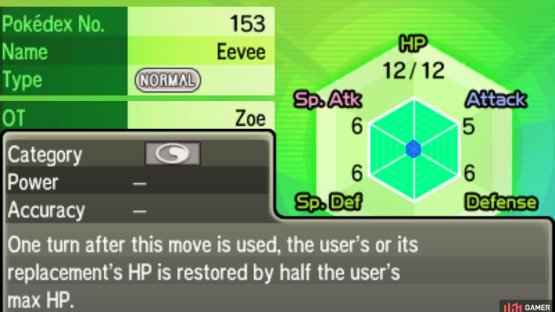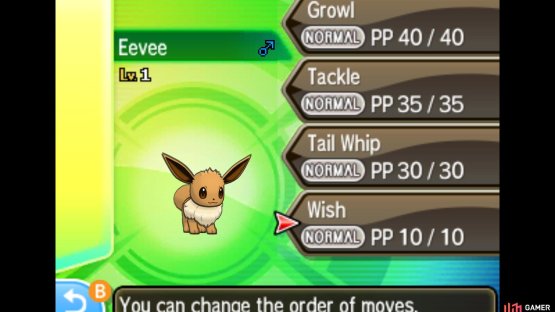(1 of 2) Breeding can be time-consuming, but it’s well worth the effort!
Breeding can be time-consuming, but it’s well worth the effort! (left), (right)
For those seeking to dive into the competitive battling scene, or those who wish to conquer the Battle Tree and Battle Royal, breeding is an absolute must-have tool to add to your toolbox. It takes some time and practice and might seem intimidating, but really it boils down to simple steps being strung together.
Any Pokémon that can be bred should be bred if you are seeking absolute perfection. This section will arm you with everything you need to know about breeding from start to finish and will also provide an example breeding project that will walk you through the steps. Feel free to follow too!
Before you dive in, you will want to have some prior knowledge, so make sure you know about IVs, natures, and EVs, which were discussed in the previous section, Pokémon 101.
Breeding is all about controlling nature and IV spreads, and even moves, to improve your chances of getting a perfect Pokémon. You wouldn’t enter a sports competition without the best gear you can find, right?
Perfect or flawless means the Pokémon has an optimal (or at the very least, deliberately chosen) nature, select egg moves, and perfect IVs where they are necessary (usually 5 or 6 IVs will be 31).
Basic Terminology¶
Egg Group: Not every Pokémon can breed with every other Pokémon. For example,  Gastly and
Gastly and  Dratini cannot breed. Why not? They’re in different Egg Groups. There are several Egg Groups and each contains specific Pokémon. Some Pokémon, like Legendaries, cannot breed at all.
Dratini cannot breed. Why not? They’re in different Egg Groups. There are several Egg Groups and each contains specific Pokémon. Some Pokémon, like Legendaries, cannot breed at all.
To go back to our example, Gastly is in the Amorphous Egg Group and Dratini is in the Dragon Egg Group (and Water 1). If you want to breed Dratini, you’re better off using a Dratini of the opposite sex, a Pokémon in the Dragon or Water 1 egg group (such as  Charmander or
Charmander or  Horsea), or a
Horsea), or a  Ditto.
Ditto.
Some Pokémon, like the Dratini mentioned, are in two Egg Groups. This makes them valuable for doing things like being viable fathers to more Pokémon, and passing down Egg moves that are hard to obtain otherwise. Other Pokémon, like  Beldum, can only breed with Ditto.
Beldum, can only breed with Ditto.
Compatibility: Just because two Pokémon can breed doesn’t mean they’ll have a high chance of producing Eggs, which can make breeding take longer if you go for long stretches of time with no Eggs to hatch or receive.
Compatibility is at its lowest if the Pokémon are different species from the same Trainer OT, but is at its highest for same species from two different Trainer OTs. Same species from the same trainer and different species from different trainers has the same compatibility level.
(1 of 2) Egg moves can help diversify your Pokemon’s options in battle.
Egg moves can help diversify your Pokemon’s options in battle. (left), (right)
Egg Moves: Moves a Pokémon can only learn by being bred with a parent who knows them. Almost never learned through TM or level up, making them unique and often quite handy. For example,  Eevee can learn Wish through Egg move, but can’t get it anywhere else.
Eevee can learn Wish through Egg move, but can’t get it anywhere else.
In Generation VII, mothers and fathers can both pass down Egg Moves. You can pass down multiple Egg Moves at once (for example, one move from each parent, or two moves from one parent, etc.)
Chain Breeding: Related to Egg moves. Chain breeding is often necessary to get specific combinations of multiple Egg moves onto the final offspring. Some Pokémon have Egg Moves in their arsenal, but the only way to get the parents to pass them down is for the parents to be bred as well. This often happens when jumping across Egg Groups.
IV Breeding: The process of breeding to get as many perfect IVs as possible. Abuses the Destiny Knot.
Additionally, here is some generic terminology you’ll want to be familiar with. These were discussed in full detail earlier but are here again for the sake of coverage and convenience:
Ability: A Pokémon’s special ability, which affects battle. All Pokémon have an ability or two, and most Pokémon have a secret (and sometimes very awesome) ability known as a “Hidden Ability”. Getting a Hidden Ability is only possible through S.O.S. Chaining or transfering from a previous generations (via the Friend Safari, Dream World, etc.).
If you’re hunting for a specific ability, bring a Pokémon that knows Simple Beam or another Ability-changing move, as this will force the HUD to show the enemy’s ability. The Ability Capsule can swap between a Pokémon’s two normal abilities, but will never give you a Hidden Ability, unfortunately.
Nature: Causes one stat to rise by 10% and another to fall by 10%. Huge modifier! Make sure you pick the right one. Mathematically speaking, a nature will change a Pokémon’s final stats at Level 100 moreso than perfect IVs.
Base Stats and Base Stat Total: Base Stats are the innate numbers of a Pokémon. These never change and are the same by species. Base Stats are the reason  Alakazam has such high Special Attack and Speed, but paltry Defense, and why
Alakazam has such high Special Attack and Speed, but paltry Defense, and why  Blissey has the most HP in the game, but terrible Attack.
Blissey has the most HP in the game, but terrible Attack.
Alakazam has base 135 Special Attack and Blissey has base 255 HP (the highest base stat possible). Base Stat Total is just adding up all of a Pokémon’s numerical base stats.  Arceus currently holds the highest total for a non-mega evolved Pokémon at 720 (all of its stats are 120 base).
Arceus currently holds the highest total for a non-mega evolved Pokémon at 720 (all of its stats are 120 base).
The numbers you see on your end of the game are the base stats being affected by level, nature, IVs, and EVs.
IVs, or Individual Values: Ranging from 0 to 31, these are numbers that just are tacked on flat through addition to Pokémon’s stats. They manifest to their maximum at level 100, and can vastly affect how a Pokémon performs in battle. Generally, aim for 31.
EVs or Effort Values: Earned through defeating Pokémon, 4 EVs = +1 to a stat at level 100. 8 EVs = +1 at level 50. You can have max 252 EVs to a stat (+63 to a stat at level 100) and max 510 EVs total. The most common spread is 252/252/6.
This results in +63 to two stats of choice (at Level 100) and +1 to a miscellaneous stat (usually HP if it’s not being maxed). Totally under player control.








No Comments